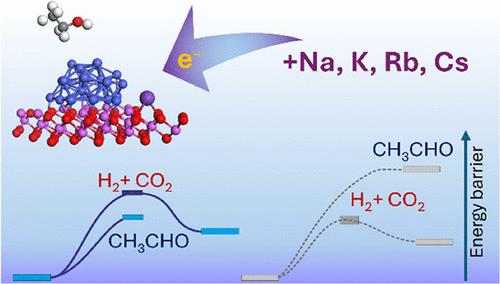Unraveling the Role of Alkali on Cobalt Catalyst Performance in Ethanol Steam Reforming by Operando DRIFT Studies and DFT Modeling
IF 8.2
2区 材料科学
Q1 MATERIALS SCIENCE, MULTIDISCIPLINARY
引用次数: 0
Abstract
Hydrogen, a sustainable and environmentally friendly fuel, can be obtained through the ethanol steam reforming (ESR) process. The most promising catalysts for this process are those based on non-noble metals such as cobalt. The activity, selectivity, and stability of these catalysts strongly depend on the presence of alkali dopants. In this work, we have taken on the challenge of understanding the role of alkali. We synthesized a series of cobalt-containing catalysts supported on α-alumina and doped with Na, K, Rb, and Cs, which were thoroughly characterized using spectroscopic and microscopic techniques. We elucidated the significant difference in the efficiency of undoped and alkali-doped catalysts, based on diffuse reflectance infrared Fourier transform (DRIFT) operando spectroscopy studies under ESR conditions. The catalytic test results indicated a strong effect of alkali promoters on the interaction between the acetaldehyde byproduct and the Co/α-Al2O3 catalyst surface. Experimental data were confronted with the results of periodic DFT-GGA+U molecular modeling. It has been shown that electron transfer from alkali atoms to the cobalt active phase strongly influences the ethanol reforming pathway by increasing the adsorption energy of the aldehyde intermediate and facilitating the key C–C bond-breaking step.

用Operando DRIFT研究和DFT模型揭示碱对乙醇蒸汽重整中钴催化剂性能的影响
氢是一种可持续的环保燃料,可通过乙醇蒸汽重整(ESR)工艺获得。在这一过程中最有希望的催化剂是那些基于非贵金属如钴的催化剂。这些催化剂的活性、选择性和稳定性在很大程度上取决于碱掺杂剂的存在。在这项工作中,我们接受了理解碱的作用的挑战。我们合成了一系列以α-氧化铝为载体,掺杂Na、K、Rb和Cs的含钴催化剂,并用光谱和显微技术对其进行了表征。基于ESR条件下的漫反射红外傅里叶变换(DRIFT)操作光谱研究,我们阐明了未掺杂和掺碱催化剂效率的显著差异。催化实验结果表明,碱促进剂对乙醛副产物与Co/α-Al2O3催化剂表面的相互作用有较强的影响。实验数据与周期DFT-GGA+U分子模拟结果相吻合。研究表明,电子从碱原子转移到钴活性相,通过增加醛中间体的吸附能和促进关键的C-C断键步骤,强烈影响乙醇转化途径。
本文章由计算机程序翻译,如有差异,请以英文原文为准。
求助全文
约1分钟内获得全文
求助全文
来源期刊

ACS Applied Materials & Interfaces
工程技术-材料科学:综合
CiteScore
16.00
自引率
6.30%
发文量
4978
审稿时长
1.8 months
期刊介绍:
ACS Applied Materials & Interfaces is a leading interdisciplinary journal that brings together chemists, engineers, physicists, and biologists to explore the development and utilization of newly-discovered materials and interfacial processes for specific applications. Our journal has experienced remarkable growth since its establishment in 2009, both in terms of the number of articles published and the impact of the research showcased. We are proud to foster a truly global community, with the majority of published articles originating from outside the United States, reflecting the rapid growth of applied research worldwide.
 求助内容:
求助内容: 应助结果提醒方式:
应助结果提醒方式:


